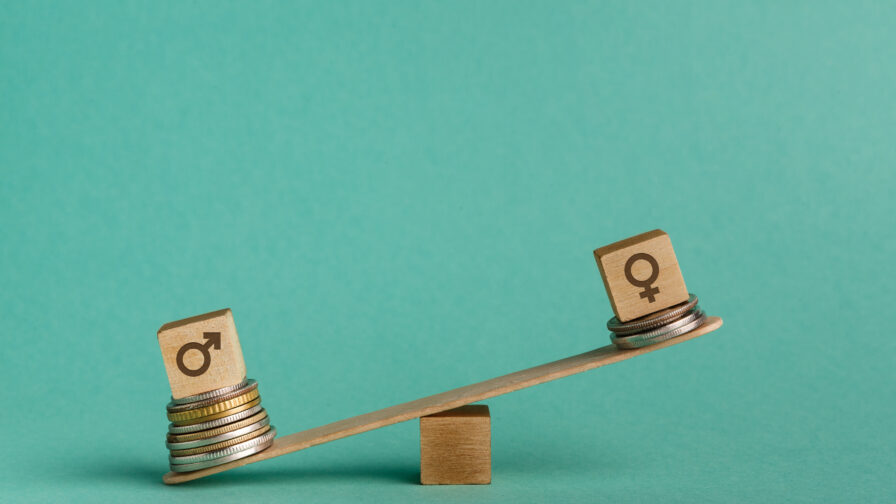
Why the Gender Pay Gap Persists in American Businesses
By Molly Mitchell
Women have progressed a lot in terms of workplace gender equity since the days of Rosie the Riveter, but elements of inequity remain stubbornly in place. In 2024, for example, women still earn around 84 cents for every dollar a man earns for the same job on average in the US – almost the same as it was twenty years ago.
The Darden Report recently caught up with Professor Allison Elias, author of “The Rise of Corporate Feminism,” to explore the history of this continuing gender pay gap, where things stand today and new research on this dynamic.

Allison Elias’s 2022 book, “The Rise of Corporate Feminism,” was named a Best Summer Book of 2023: Business by the Financial Times.
What is the gender pay gap?
The gender pay gap refers to the difference in earnings between women and men. Specifically, it is the ratio of women’s to men’s median earnings, according to the U.S. Census Bureau, for full-time workers. And importantly, the often-cited 80 percent statistic provides an incomplete picture of women’s experiences in the labor market since the gap is exacerbated for many women of color. Hispanic and Black women experience the largest gaps relative to white, non-Hispanic men.
Why does the gender pay gap happen?
There are many reasons that the gender pay gap exists. Economists label these reasons as supply side (women’s choices) and demand side (employers’ choices), although it can be difficult to untangle the two or categorize them neatly as one or the other.
Traditionally, women have had lower educational attainment, been segregated into jobs that paid lower wages and had less continuous experience in the labor force. But we cannot attribute these trends to women’s choices alone. Legal constraints, economic structures and gender norms have also played a role in shaping women’s preferences and choices. Sociologists may even argue that career preferences emerge in childhood from gender-specific socialization processes.
On the demand side, gender discrimination (at the point of hire and beyond) has contributed to lower pay and fewer promotional opportunities for women. However, it is difficult to measure the extent to which implicit and explicit attitudes of employers account for the wage gap.
Do certain professions/fields experience the gap more than others?
The gender pay gap tends to increase as pay increases, in part because the minimum wage creates a floor for lower earners. People in managerial and professional work, where jobs are more gender integrated, see higher wage gaps than those in jobs requiring a high school degree.
Regarding MBA graduates, the gender wage gap tends to increase over time. Researchers at one top program examined multiple cohorts of MBA graduates 13 years following graduation and found that parenthood impacted women’s earnings more so than men’s. At 13 years out from graduation, women were earning 56 percent of what their male classmates earned. Factors like taking time away from work and working even a few hours fewer per week were found to have tremendous impact on women’s earnings later in their careers. Caregiving responsibilities have a negative influence on women’s earnings (e.g., the motherhood penalty), whereas men have been shown to actually earn more upon becoming fathers! For those in the highest-paid jobs, the returns for what sociologists call overwork are huge, and contribute significantly to sustaining the wage gap.
At a more micro level, we also know from experimental research in social psychology that women receive less credit—and also claim less credit—for their work when engaged in joint tasks with men. I have a recent paper coauthored with Jirs Meuris at Wisconsin where we examine almost two decades of data to demonstrate the effect on the gender wage gap of a job’s interdependence, meaning the extent to which a job requires working on a team or coordinating with others. Over time and across industries and occupations, jobs that are rated as more interdependent, meaning they require two or more people to sequentially complete tasks, have higher gender wage gaps.
This makes sense given what we know from social psychology about credit for joint work: In mixed gender groups, women receive and claim less credit, which could influence reward allocation. But also, we find that the gender of the task matters. The gender wage gap is exacerbated in male-dominated occupations and is lessened in female-dominated occupations. Rewarding individual contributions in interdependent work settings is more complex and can sustain and worsen gender inequality, particularly in traditionally male settings.
Managers who wish to address this trend should revisit their performance evaluation systems, which were likely designed with independent work in mind. With increasing numbers of employees engaged in interdependent jobs, managers need to find new ways to evaluate individual contributions and rely on multiple sources when determining rewards.
How much progress towards equity have we made?
Since 1960 the gap has narrowed, although it has hovered around 80 percent for several decades. Despite continuing inequities, women are more likely to graduate from high school, graduate from college and earn master’s degrees. They earn half of all doctorates. In MBA programs, women represent 47 percent of those receiving graduate business degrees from U.S. business schools (in 2020)—a significant increase from less than 5 percent in 1970.
Furthermore, women have gained control over reproduction with the dissemination of a birth control pill, and age at first marriage has continued to rise along with the percentage of women who prioritize career success. These factors are interrelated: investment in education—and interest in career advancement—becomes more attractive for women who have more control over family planning.
While there is much progress in educational attainment, the pay gap is largest in the highest-paid jobs that demand overwork, which economist Claudia Goldin calls “greedy jobs.” Jobs that are highly compensated, such as finance or corporate law, pay disproportionately more on a per-hour basis when they require more time (more than 40 hours a week) and offer less flexibility. A gender pay gap is sustained in these jobs because women are more likely to choose a more flexible path that does not have such high rewards for overwork. Goldin, who recently won the Nobel Prize, calls this issue the “last chapter” in the converging economic roles of men and women.
I have a forthcoming case with economist Peter Debaere about Goldin’s work, which uses protagonists from both of our books, “To America and Back Again” (English for: “Naar jouw Amerika en terug”), and “The Rise of Corporate Feminism,” to illustrate certain historical trends in women’s labor force participation.
Important to note is that even though women in the highest-paid work face the highest wage gap penalties, in general women remain overrepresented in the lowest-paying occupations. And occupations with greater proportions of women tend to pay less even when controlling for educational and skill requirements. Occupational gender segregation intersects with race and ethnicity. As of 2019, white men were overrepresented in jobs with the highest pay (e.g., physician, chief executive, financial investment, pilot, architect) and women (white, Black and Latina), as well as Black and Latino men, were overrepresented in jobs with the lowest pay (e.g., food service, childcare, cashier). So while the gender wage gap is lower among those with less education, occupational segregation remains high in those jobs.
What practical policies or actions are most effective in closing the gender wage gap?
It is difficult to declare one specific remedy for the gender wage gap. Recommendations usually target change at the individual or organizational level while governments are also forwarding interventions. For individuals, there has been much emphasis on women’s propensity (or lack thereof) to negotiate their starting salaries, particularly with the publication and dissemination of “Women Don’t Ask,” a groundbreaking book from 2003.
Recent research using MBA data from management professors Laura Kray, Jessica Kennedy and Margaret Lee suggests that actually women do ask, and the wage gap for this population is no longer an individual-level phenomenon. Instead, organizations and governments should advance solutions, and there is promise in at least two remedies: banning salary history and promoting pay transparency.
Given the historic lack of pay transparency in the private sector, companies are increasingly opting to perform audits to try to ensure pay equity regardless of gender or race. And states are adopting laws to ban an employer’s questions about a candidate’s previous salary, which has been shown to improve salary outcomes for women and underrepresented minorities. Under consideration at the federal level is the Paycheck Fairness Act, which would expand coverage for equal pay and also ban salary history considerations and promote pay transparency.
The University of Virginia Darden School of Business prepares responsible global leaders through unparalleled transformational learning experiences. Darden’s graduate degree programs (MBA, MSBA and Ph.D.) and Executive Education & Lifelong Learning programs offered by the Darden School Foundation set the stage for a lifetime of career advancement and impact. Darden’s top-ranked faculty, renowned for teaching excellence, inspires and shapes modern business leadership worldwide through research, thought leadership and business publishing. Darden has Grounds in Charlottesville, Virginia, and the Washington, D.C., area and a global community that includes 18,000 alumni in 90 countries. Darden was established in 1955 at the University of Virginia, a top public university founded by Thomas Jefferson in 1819 in Charlottesville, Virginia.
Press Contact
Molly Mitchell
Associate Director of Content Marketing and Social Media
Darden School of Business
University of Virginia
MitchellM@darden.virginia.edu




